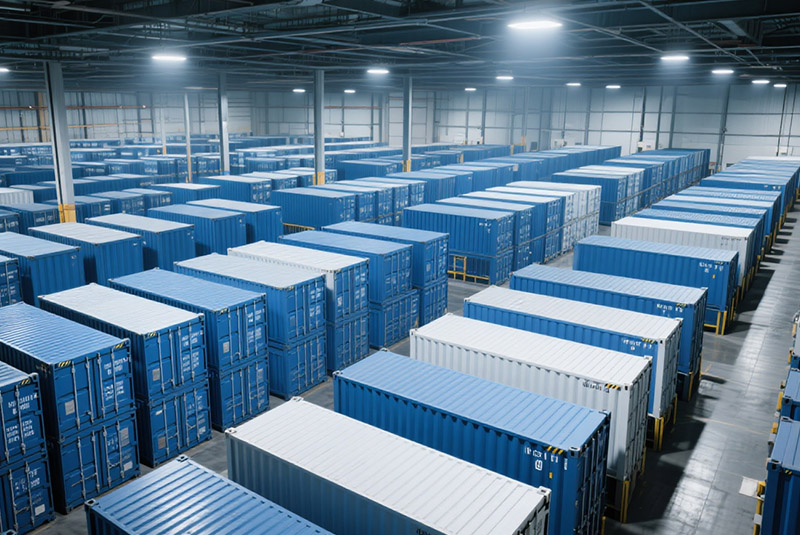Container size
此处添加图片
The impact of container size enables factories to load goods at their facilities. They can then deliver them to stores and warehouses without having to unload or transfer goods along the way. As a result, people can have goods in optimal shape and delivery capacity, no matter how far from the original factory they are. E-Chain Logistics uses containers to ensure your goods arrive safely from country A to country B.
Is it true that ships transport around 90% of the world’s cargo? Well, it’s not surprising that such a large volume of cargo uses these ships. There are different types of containers in circulation, each with a different purpose. Read below to find out:
The most common container types
此处添加图片
Customers can arrange container transportation through E-Chain logistics Company.
Here are the 12 most common container types!
dry cargo container
General-purpose shipping containers, also known as “dry cargo containers,” are the most common type of shipping container. They are used to transport dry materials and come in 20-foot, 40-foot, and 10-foot lengths. These shipping containers are enclosed and protected from the elements. They are also weatherproof and have rigid roofs, sidewalls, and floors.
此处添加图片
20-foot container: internal volume 5.69mx 2.13mx 2.18m, gross weight 17.5 tons, volume 24-26 cubic meters.
40ft container: 11.8m long, 2.13m wide, 2.18m high, gross weight approximately 22 tons, volume 54 cubic meters.
40-foot high container: length 11.8m, width 2.13m, height 2.72m, gross weight 22 tons, volume 68 cubic meters.
此处添加图片 此处添加跳转按钮
CONTACT US
Flatbed shipping containers
These sides fold down, like simple storage and shipping containers. The sides can be folded down to create a flatbed for transporting a variety of cargo. This makes them ideal for transporting oversized cargo, such as large machinery , railcars, and construction materials . Some 40 -foot flatbed containers are suitable for carrying up to 45 metric tons!
此处添加图片
Open top container
It features a fully removable convertible roof that converts to a convertible top. This allows for the transport of materials of any height, such as tall machinery or other heavy finished products . Handling and loading can only be done with a crane or roller bridge. Open-top containers are equipped with lashing rings on the upper and lower side rails. Corner posts for securing cargo are available in 20-foot and 40-foot lengths.
此处添加图片
Tunnel container
Also known as double-door containers, these have doors at both ends. They facilitate quick loading and unloading of materials. They also provide more space for commodities such as steel. Both sets of doors have identical locking assemblies and weather seals to protect cargo from the elements.
Side-opening container
此处添加图片
These storage units have doors that open completely sideways, creating a wider area for loading materials. Open-top containers typically come in 20-foot and 40-foot lengths. They offer ample space for oversized items that wouldn’t fit through regular doors.
refrigerated containers
此处添加图片
They are used to transport temperature-sensitive, perishable goods, such as meat, fruits, and vegetables. Refrigerated shipping containers are equipped with a system that helps maintain the internal temperature between -25°C and +25°C. Contrary to popular belief, these refrigerated containers do not regulate temperature; they only maintain it. This container type relies on an external power source to control the temperature. Refrigerated containers typically come in 20-foot and 40-foot lengths .
此处添加图片
Insulated shipping containers
Insulated shipping containers feature adjustable temperature control, enabling them to withstand higher temperatures (such as refrigerated ISO shipping containers). Furthermore, they have electrical compliance (mechanical compressors) to cool or heat the air inside the container. Insulated containers are constructed from vacuum-sealed flasks, like “Thermos” bottles. Therefore, they are best suited for long-distance transport of products such as food, pharmaceuticals, organs, blood, biological materials, and chemicals.
此处添加图片
Cargo storage roll shipping container
Collapsible containers are specialized container units for transporting sets or piles of materials. They are made of thick, sturdy wire mesh and have rollers for easy movement. The availability of a range of colored wire mesh makes these container units even more enjoyable.
此处添加图片 此处添加跳转按钮
CONTACT US
Half-height container
Another type of shipping container includes half-height containers, which are primarily made of steel. These containers are half the height of full-size containers. Half-height containers have a lower center of gravity. Therefore, they can handle heavier loads better than taller containers, making them versatile. They are also strong enough to withstand harsh industrial environments. They are primarily used for loading and unloading coal, stone, and other materials that require easy handling.
Motor carrier container
此处添加图片
Car transporters are container storage units specifically made for transporting cars over long distances. They come with foldable sides. This helps the car fit inside the container without risk of damage or movement from the site.
Double-door container
Double doors make it easy to enter the store, retrieve and sort goods or materials. By adding partitions, double-door containers can be modified to create separate storage spaces, container offices, or set up a pair of retail kiosks.
此处添加图片
tank container
Tank containers or tank trucks are made of solid steel or other corrosion-resistant materials and are used for the transportation and long-life protection of liquid materials. Tank containers must be at least 80% full to prevent dangerous liquid surges during transportation. However, they cannot exceed 95% or there will be insufficient room for thermal expansion.
But what are the dimensions of the container?
Shipping containers are sized to specific ISO standards. These require that all containers be within a few millimeters of each other. This allows them to be stacked easily on container ships. Containers are quantified into twenty-equal units (TEUs) and are mostly built in 20- and 40-foot lengths. A standard container has an exterior height of 8 feet 6 inches. A “high cube” container has an exterior height of 9′ 6″.
此处添加图片 此处添加跳转按钮
CONTACT US
Standard outer container dimensions
| Container length |
8ft |
10ft |
20ft |
30ft |
40ft |
| Container width |
7 feet 1 inch |
8ft |
8ft |
8ft |
8ft |
| Container height |
|
|
|
|
|
| standard |
7 feet 5 inches |
8 feet 6 inches |
8 feet 6 inches |
8 feet 6 inches |
8 feet 6 inches |
| High Cabinet |
– |
9 feet 6 inches |
9 feet 6 inches |
9 feet 6 inches |
9 feet 6 inches |
Standard inner container dimensions
| Internal length |
7 feet 6 inches |
9 feet 2 inches |
19 feet 3 inches |
29 feet 4 inches |
39 feet 4 inches |
| Internal width |
6 feet 11 inches |
7 feet 7 inches |
7 feet 7 inches |
7 feet 7 inches |
7 feet 7 inches |
| Internal height: |
|
|
|
|
|
| ” standard |
6 feet 8 inches |
7 feet 9 inches |
7 feet 9 inches |
7 feet 9 inches |
7 feet 9 inches |
| ” High Cabinet |
– |
8 feet 9 inches |
8 feet 9 inches |
8 feet 9 inches |
8 feet 9 inches |
| End door opening width |
6 feet 10 inches |
As requested. |
7 feet 6 inches |
7 feet 6 inches |
7 feet 6 inches |
| End door opening height |
|
|
|
|
|
| ” standard |
6 feet 4 inches |
As requested. |
7 feet 5 inches |
7 feet 5 inches |
7 feet 5 inches |
| ” High Cabinet |
– |
As requested. |
8 feet 5 inches |
8 feet 5 inches |
8 feet 5 inches |
| Building area |
51 square feet |
72 square feet |
150 square feet |
227 square feet |
305 square feet |
| Cubic capacity |
|
|
|
|
|
| ” standard |
348 cubic feet |
560 cubic feet |
1160 cubic feet |
1760 cubic feet |
2360 cubic feet |
| ” High Cabinet |
– |
630 cubic feet |
1310 cubic feet |
1985 cubic feet |
2660 cubic feet |
| weight |
1 ton |
1.5 tons |
2.4 tons |
3.2 tons |
4 tons |










